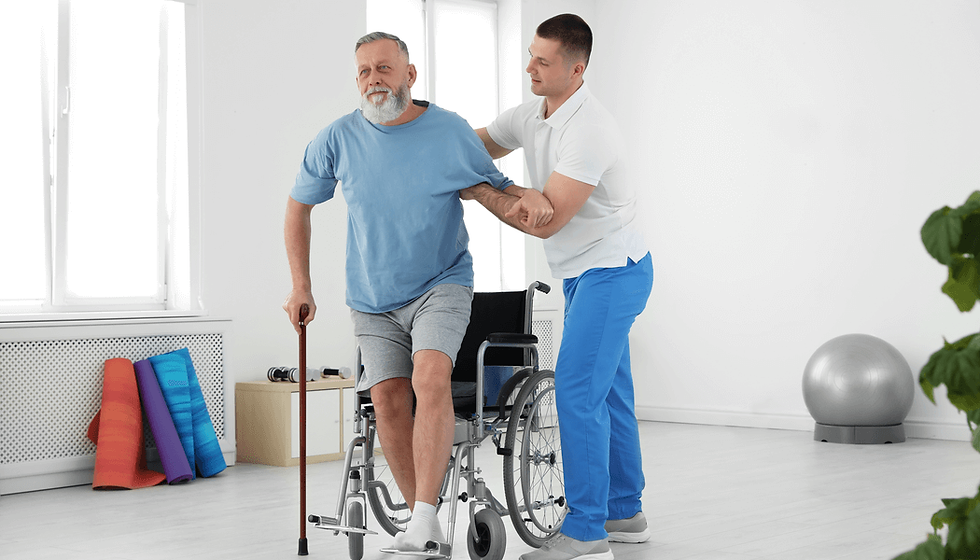Ankle-Foot Orthoses (AFOs) in Neurorehab: Walk Stronger, Safer & Smarter
- Sven Rees

- May 19, 2025
- 3 min read
Updated: Jul 24, 2025
Supporting Gait, Improving Function
Do you or your loved one struggle with foot drop, ankle weakness, or an unsteady gait due to a neurological condition? You might feel hesitant to walk outdoors or afraid of tripping—even for short distances.
Ankle-Foot Orthoses (AFOs) are custom devices that help improve walking stability, foot clearance, and confidence in people with neurological conditions. At Exercise Matters, we use AFOs as part of a broader neurorehabilitation strategy to help clients move more freely and safely.
What Is an AFO?
An AFO is a brace worn on the lower leg and foot to support ankle positioning and foot alignment. It:
Holds the foot in a neutral position
Prevents foot drop during the swing phase of walking
Enhances knee stability during stance
Supports balance and energy efficiency
Who Might Benefit from an AFO?
People with neurological conditions that affect motor control, strength, or coordination:
Cerebral Palsy
Spinal Cord Injury
Traumatic Brain Injury
Types of AFOs
1. Solid AFO
Rigid and supportive
Used for significant foot drop, spasticity, or poor control
Limits ankle movement for stability
2. Hinged AFO (Articulated)
Allows controlled ankle movement
Supports dorsiflexion while enabling some plantarflexion
Suitable for clients with mild to moderate weakness
3. Carbon Fibre AFO (Dynamic Response)
Lightweight and energy-returning
Promotes smoother gait and improved propulsion
Often used for more active clients
4. Posterior Leaf Spring AFO
Flexible ankle support
Assists foot clearance during swing phase
Common for mild foot drop
How AFOs Help in Neurological Rehabilitation
Foot Drop Correction: Prevents toe drag and tripping risk
Improved Step Length and Gait Symmetry
Enhanced Walking Speed and Endurance
Better Balance and Fall Reduction
Reduced Energy Cost of Walking
Evidence: Tyson et al. (2013) found that AFOs significantly improved walking speed, safety, and confidence in stroke survivors. Similar outcomes have been observed in MS and CP populations.
The Role of Exercise Physiology in AFO Prescription and Integration
At Exercise Matters, our Exercise Physiologists:
Work alongside orthotists and physiotherapists
Assess gait biomechanics before and after AFO use
Design gait retraining programs with or without AFOs
Support lower limb strength and neuromotor control
Teach proper donning/doffing and maintenance
We ensure AFO use is functionally integrated—not just worn, but used with purpose.
Case Study: Natalie, 42, Post-Stroke with Left Foot Drop
Natalie experienced frequent tripping and fatigue during walking. After being fitted with a hinged AFO:
Her 10-metre walk test time improved by 20%
Her walking endurance doubled
She regained confidence to walk outdoors independently
Our Exercise Physiology team worked with her on step training, hip flexor strengthening, and foot clearance drills with her AFO.
Step Forward With Confidence
An AFO isn’t just a brace—it’s a tool to help you walk with more freedom, safety, and strength. Let us help you find the right support and integrate it into your recovery journey.
📞 Call (07) 5448 3532
References:
Tyson SF et al. (2013). Effectiveness of AFOs in stroke rehabilitation: a systematic review. Clin Rehabil.
Nolan KJ et al. (2018). The impact of dynamic AFOs on gait in neurological conditions. Gait Posture.
Bowers R et al. (2020). Clinical decision-making in orthotic prescription. Prosthet Orthot Int.
Frequently Asked Questions
Do I need a referral to get an AFO?
Yes. A referral from a neurologist, physiotherapist, or orthotist is typically required. We assist in coordinating this process.
Will I need to wear it forever?
Not always. Some clients use AFOs as a transitional aid while improving strength and gait through therapy.
Can I exercise while wearing an AFO?
Yes. Many exercises can be done safely with an AFO. We modify movements to suit your device and goals.
Can I get AFOs through NDIS?
Yes. AFOs are funded under NDIS assistive technology. We provide supporting reports and therapy documentation.






Comments